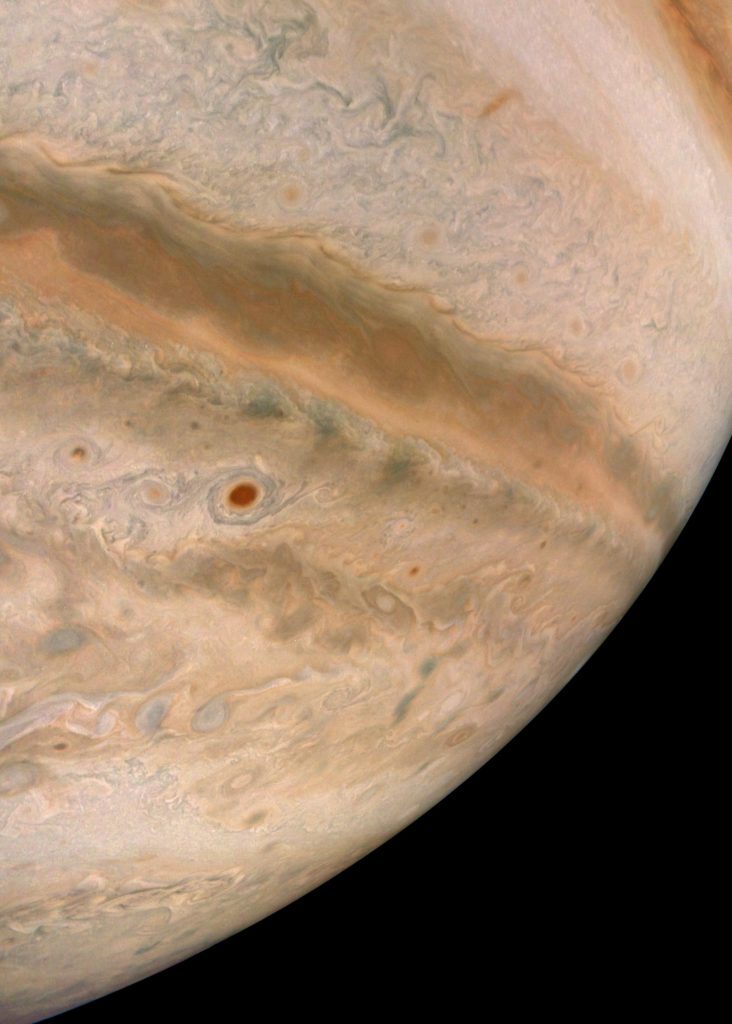Jupiter – a heavy metal planet?
An international team of astronomers, among Michaël Bazot from the “Theory and Observations of Stars” (TOS) group at HITS, has found that Jupiter’s gaseous envelope doesn’t have a homogeneous distribution. The inner part has more metals than the outer parts, and kilometer-sized bodies—planetesimals—must have played a role in Jupiter’s formation.

When NASA’s Juno space mission arrived at Jupiter in 2016, we caught a glimpse of the remarkable beauty of the biggest planet in our Solar System. Besides the famous Great Red Spot, Jupiter turns out to be littered with hurricanes, almost giving it the appearance and mystique of a Van Gogh painting. The planet’s envelope underneath the thin visible layer however, is not immediately apparent. Still, Juno is able to paint us a picture by sensing the gravitational pull above different locations on Jupiter. This gives astronomers information about the composition of the interior, which is different from the surface.
An international team of astronomers, led by Yamila Miguel (SRON Netherlands Institute for Space Research /Leiden Observatory), now found that the gaseous envelope is not as homogenous and well-mixed as previously thought. Instead it has a higher contraction of “metals”—elements heavier than hydrogen and helium—towards the center of the planet. To reach their conclusions, the team built a number of theoretical models that adhere to the observational constraints measured by Juno.
The team studied the distribution of metals to extract signs of how Jupiter was formed. HITS researcher Michaël Bazot (TOS group) was the second author in the study. He developed the statistical algorithm that produced the several millions of models of Jupiter necessary to meaningfully explore the interior of the planet.
The researchers found that metals are not distributed homogeneously across the envelope, with a higher fraction of metals in the inner part than in the outer parts of Jupiter. The total adds up to between 11 and 30 earth masses worth of metals. The finding that the inner part of the envelope has more heavy elements than the outer part, means that the abundance decreases outward with a gradient, instead of there being a homogeneous mixing across the envelope. “Earlier we thought that Jupiter has convection, like boiling water, making it completely mixed,” says Miguel. “But our finding shows differently.”
Publication:
Y. Miguel, M. Bazot, T. Guillot, S. Howard, E. Galanti, Y. Kaspi, W. B. Hubbard, B. Militzer, R. Helled, S. K. Atreya, J. E. P. Connerney, D. Durante, L. Kulowski, J. I. Lunine, D. Stevenson, S. Bolton, ‘Jupiter’s inhomogeneous envelope’, Astronomy & Astrophysics, Volume 662, June 2022. https://www.aanda.org/articles/aa/full_html/2022/06/aa43207-22/aa43207-22.html
Scientific Contact:
Michael Bazot, TOS group
Heidelberg Institute for Theoretical Studies
Yamila Miguel, SRON / Leiden Observatory, The Netherlands
https://www.yamilamiguel.com/#
Y.Miguel@sron.nl
About HITS
HITS, the Heidelberg Institute for Theoretical Studies, was established in 2010 by physicist and SAP co-founder Klaus Tschira (1940-2015) and the Klaus Tschira Foundation as a private, non-profit research institute. HITS conducts basic research in the natural, mathematical, and computer sciences. Major research directions include complex simulations across scales, making sense of data, and enabling science via computational research. Application areas range from molecular biology to astrophysics. An essential characteristic of the Institute is interdisciplinarity, implemented in numerous cross-group and cross-disciplinary projects. The base funding of HITS is provided by the Klaus Tschira Foundation.